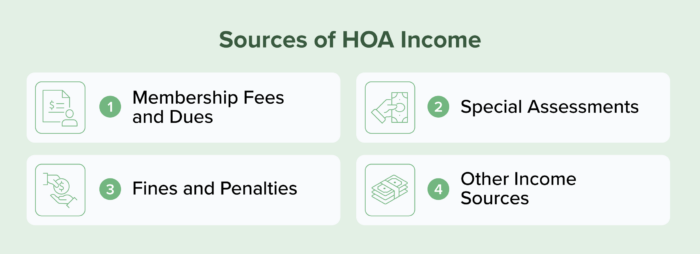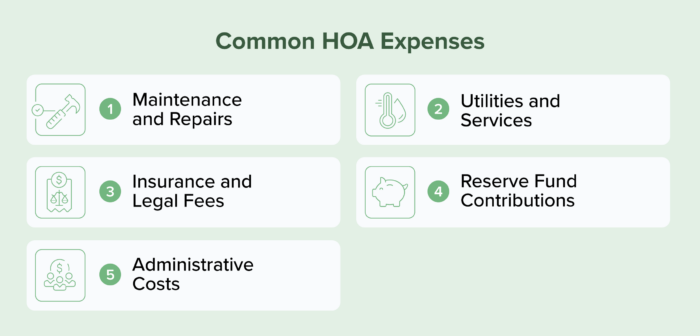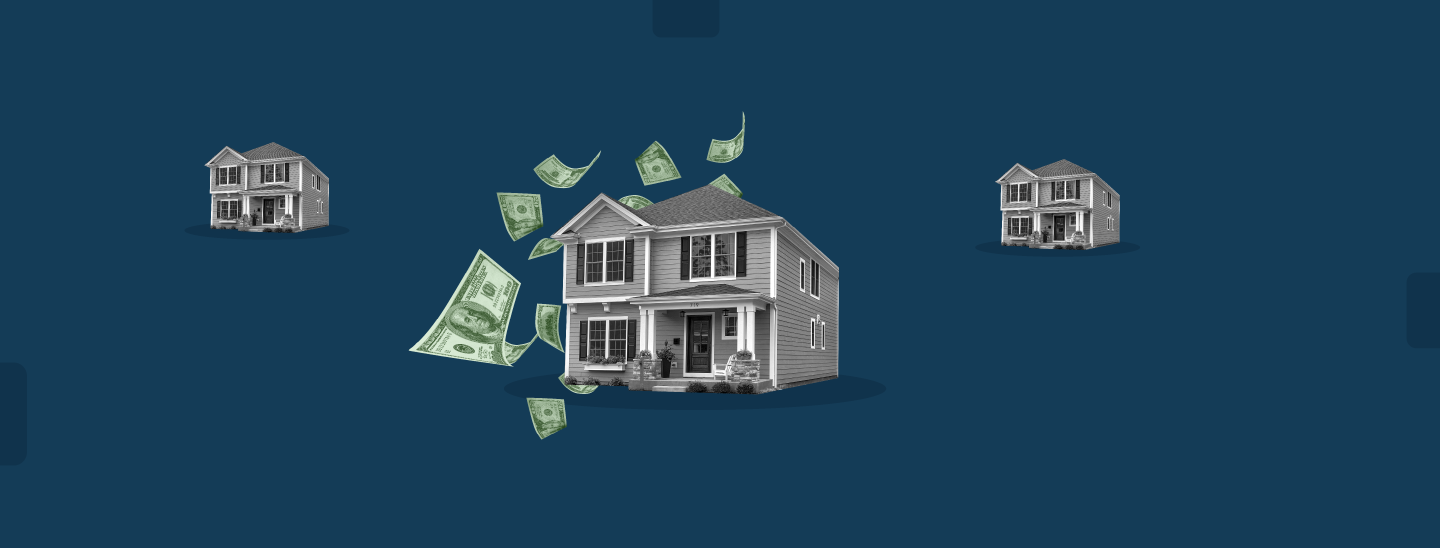One of the biggest responsibilities you’ll have as an association manager is keeping your HOA’s finances in good shape. And if you’re new to the job, you might be wondering exactly what that looks like on a day-to-day basis. How do you ensure the budget stays on track? What steps should you take to maintain financial health for the long haul?
No-Fuss Financials
Automated bookkeeping to simplify accounting a grow your business.
Learn MoreIn this guide, we give you the full HOA finances picture. From handling monthly expenses to planning for future projects, we’ll dive deep into the essential details—and give you a clearer understanding of what to expect.
Understanding HOA Finances
Before getting into the weeds on the basics of HOA finances, it’s important to have a high-level understanding of what they are and why they are important.
What are HOA Finances?
At their core, HOA finances encompass all of the financial tasks that a property manager and their board members have to oversee on a regular basis, such as:
- Creating an operating and capital budget
- Collecting and tracking HOA fees
- Managing delinquencies
- Building up reserve funding
- Consulting reserve studies
- Maintaining HOA accounting best practices
- Conducting regular internal and external audits
Why Is Proper HOA Financial Management Important?
Finances are the backbone of any association, and managing them well is a large part of protecting a community’s longevity. When the funds are properly handled, you’ll have enough to cover routine operating costs, plan for major capital projects, and handle any unexpected expenses that come your way. All three of these play a role in keeping the association running smoothly and protecting the community’s finances.
Sources of HOA Income

Now that you have a better understanding of HOA financials as a whole and why they’re so key to the health of the association, let’s take a look at the finer details. To start, it’s a good idea to understand the different sources of income your association could bring in.
Membership Fees and Dues
As an association manager, your primary source of income comes from membership dues. These dues—whether collected monthly, quarterly, or annually—are the fees all association members pay to be part of the community.
Typically set during the annual budgeting process, these fees are allocated between operating expenses and the association’s reserve funds. The funds cover everyday maintenance as well as future projects and improvements, ensuring the community stays well-maintained and prepared for any upcoming needs.
Special Assessments
Special assessments are those unexpected extra fees that sometimes hit association members when a costly project—like an elevator upgrade or façade overhaul—comes up, and the reserves just aren’t enough to cover it.
In this situation, the cost of the project is split evenly among all the members, and each is responsible for paying their portion. They can usually do this either in one lump sum or through regular installments.
As you can imagine, special assessments aren’t exactly a hit with the community. To keep them at bay, it’s a good idea to stay ahead of the game by budgeting smartly and planning for those big-ticket repairs and upgrades long before they’re needed.
Fines and Penalties
Associations also have the authority to issue fines and penalties to members who break the rules, which can contribute to the association’s overall income. These fines, whether for late payments or violations of the community’s code of conduct, are usually determined on a case-by-case basis by the board. Since they’re only enforced as needed, it’s tough to predict how much income they’ll generate.
When a fine is issued, it’s typically added to the member’s regular statement, so they’ll pay it along with their usual dues. While fines aren’t a reliable income stream, they can provide a bit of extra revenue when rule violations occur.
Other Income Sources
Lastly, your association may also bring in income from various other sources. Every association is a bit different, but to give you a sense of what to expect, here are some common examples:
- Facility rental fees
- Laundry facility fees
- Ad income from a newsletter
- Vending machine income
- Interest income from reserve accounts
While this income can be unpredictable, it’s still important to track so you have a clear picture of your association’s overall monthly earnings.
Common HOA Expenses

Once you’ve got a clear view of your association’s income streams, it’s time to think about the expenses. These can vary depending on your community’s needs, but here are a few common categories you’ll likely see in your budget:
Maintenance and Repairs
Generally, maintenance and repair expenses cover the costs necessary to keep the association’s current assets up and running. They can include the labor and material costs for things like:
- Replacing burned-out lightbulbs
- Keeping up the landscaping
- Buying cleaning supplies
- Doing runtime repairs on the association’s HVAC system
It’s important to note that these expenses are for routine upkeep to make sure everything’s running smoothly. Bigger projects, like upgrades or major improvements, fall under the reserve budget—more on that later.
Utilities and Services
Any utilities that aren’t billed directly to individual members will need to be accounted for in the budget. This typically includes things like electricity, gas, and Wi-Fi for the common areas. However, if your association includes utility costs in the membership dues, you’ll need to consider the usage rates for the entire community.
Don’t forget to think about all the third-party services that help keep your association running. Maybe you outsource your cleaning and janitorial services, or perhaps you have hired security personnel. Either way, factor in the total cost of these services to get a clear picture of what your association spends to keep things operating year-round.
Insurance and Legal Fees
When it comes to insurance, your association’s governing documents likely outline the required policies and minimum coverage limits. From there, your insurance agent can walk you through whether your current coverage is adequate for the property and what the premiums will look like for the upcoming year.
You’ll also need to budget for attorney fees. Whether it’s consulting with outside counsel on things like emotional support animal (ESA) applications, handling delinquencies, or managing collections, legal costs can add up. Review how many hours your association’s attorney typically bills each month so you can plan for those expenses accordingly.
Reserve Fund Contributions
Each month, a portion of the association’s income will typically be transferred from its operating accounts to its reserve fund. In the HOA banking world, this is called a “reserve fund contribution,” and it’s a standard practice.
This ensures that the association is regularly building up its reserves so there’s enough money to cover future capital projects as well as any unexpected expenses that might come up down the line.
Administrative Costs
A portion of the association’s income will also go toward covering administrative costs. This expense category can cover a wide variety of fees and charges, from staff payroll to management fees and routine office expenses. However, it also commonly includes charges associated with processing paperwork, such as sending out violation notices or conducting leasing permit updates.
Budgeting for an HOA: Creating Annual Budgets
Every association needs to create two budgets on an annual basis to maintain its financial health. They are:
- An operating budget: This annual budget includes the association’s various income streams and the routine expenses needed to keep it running smoothly.
- A capital budget: This annual budget details the reserve fund contributions that you’ll make throughout the year and any larger-scale projects or improvements. The projects or improvements are often called “capital expenses.”
Typically, the board treasurer and property manager will take the first pass at creating viable drafts of these budgets. Then, they will review the drafts with a committee, often made up of dedicated members of the association, who will review the drafts and make sure they make financial sense. Once the draft has been validated, it will likely be approved by the board.
HOA Reserve Funds
A significant portion of your capital budget will be focused on making sure the association’s reserve funds are properly allocated. Let’s break down the best way to manage these funds so you can keep the association financially secure and prepared for future projects.
The Purpose of Reserve Funds
At its core, reserve funding is money that the association sets aside to cover future financial obligations and unexpected costs. Typically known as “capital projects,” these future financial obligations are usually planned upgrades or improvements to the association. Having savings that can cover both these costs prevents the association from falling into the red.
Determining Adequate Reserve Levels
In order to determine how much money an association should have in its reserve funds, board members and property managers usually turn to a reserve study. Reserve studies involve conducting an inspection of the property and, based on those results, prioritizing the capital projects that need to be completed in the near future.
Once the key members of the association have the reserve study in hand, they can decide how much reserve funding to keep on hand. Typically, this is expressed as a percentage of the total cost it would take to fund all of the projects in the reserve study.
Each state sets its own guidelines for the minimum percent funded an association must be. However, in general, the higher the percentage covered, the better. Common reserve fund accounting norms find that many associations aim to be between 70% and 100% funded.
Pro Tip: You can learn more about reserve fund best practices in our guide, The Ins and Outs of HOA Reserve Fund Accounting.
Investing Reserve Funds
Many associations choose to invest a portion of their reserve funds to help grow the balance over time. That said, each state has specific guidelines about how reserve funds can be invested, so it’s crucial to research the regulations in your area before diving in.
When in doubt, it’s best to play it safe since you’re managing large sums of money that belong to the entire community. Stick to low-risk investments that still offer a decent return, such as certificates of deposit (CDs), money market accounts, high-yield savings accounts, or U.S. Treasury products. These options tend to be solid choices for preserving the funds while allowing for some growth.
Financial Reporting and Transparency
One of the most important, consequential responsibilities you’ll face in managing an HOA’s finances is keeping your books transparent and following reporting best practices. The overview below can give you a general idea of what to expect, but be sure to consult a legal professional for more specific details on the HOAs you manage.
Monthly and Annual Financial Statements
As the property manager, one of your primary responsibilities is to generate financial statements regularly so the board members can have a clear view of the association’s financial standing. To keep everyone up to date, you should produce the following financial statements each month:
- Balance sheet
- Income statement
- Cash flow statement
- General ledger
- Accounts payable report
- Account delinquency report
- Cash disbursements ledger
In addition to putting them forth on a monthly basis, you’ll also want to run these reports annually so that you can get a sense of how the association fared over the year. These reports will also be important for auditing. (More on that later.)
Best Practices for Transparent Financial Management
As far as best practices are concerned, transparent financial management revolves around the following:
- Familiarizing yourself with the requirements: Learn about the various requirements imposed by state laws and the association’s governing documents.
- Establishing strong financial controls: Put controls in place, such as creating a clear document retention policy and doing regular bank reconciliations, so that you can ensure accurate reporting.
- Implementing clear procedures: Follow the board’s policies, but make sure there’s a clear system for how you’re dealing with everything from drafting the budget to corresponding with delinquent account holders.
Auditing and Compliance
Conducting periodic audits or reviews of the association’s financial records is equally important as proper reporting when managing HOA finances. Use the information below in tandem with advice from legal professionals to keep your processes on the straight and narrow.
The Importance of Conducting Regular Audits
Regular audits are critical for promoting financial transparency. They help ensure the accuracy of financial reports, provide association members with a clear understanding of how their funds are managed, and build trust within the community. Audits also identify areas for improvement and serve as a safeguard against financial mismanagement.
The association’s bylaws will likely state how often an audit needs to take place, but it’s considered best practice to conduct one annually. Typically, it occurs around the same time that association taxes are put in order.
Types of Audits
There are two distinct types of audits you can perform:
- Internal audit: Generally, internal audits are handled by those familiar with the association and are focused on measuring performance and finding areas for improvement.
- External audit: External audits are performed by third-party companies and are focused on vetting the validity of the association’s financial statements.
Handling Delinquent Payments
Your association likely already has a collections policy in place to manage delinquent payments. Typically, the process involves sending a reminder for the first late payment, applying late fees after the grace period, and, if necessary, handing the account over to a collections agency or pursuing legal action.
Since collections are heavily regulated, familiarize yourself with the rules. It’s also a good idea to contract out to third-party services, such as an attorney, when things escalate beyond reminders and fees.
Managing Unexpected Expenses
Unexpected expenses will pop up during your time with the association. When they do, try not to panic. Ideally, you’ll be able to tap into your reserve fund—that’s exactly what it’s there for.
If reserve funds aren’t an option, you and the board can explore other ways to cover the costs, like cutting back in other areas of the operating budget. In a worst-case scenario, you might need to impose a special assessment on members to make up the difference.
Cost-Reduction Strategies
When you need to cut costs, there are a few different cost-reduction strategies you can use:
- Renegotiate with vendors: Reach out to current service providers to discuss potential cost savings. This can include negotiating lower rates, extending contract terms for better pricing, or finding alternative vendors who offer competitive pricing. The goal is to reduce expenses without compromising the quality of services provided to the community.
- Push back non-essential projects: Delay or postpone projects that are not immediately necessary. By prioritizing essential projects and deferring others, the HOA can manage its cash flow more effectively and allocate funds to more critical areas.
- Temporarily reduce reserve fund contributions: Lower the amount of money set aside for future repairs and replacements. While this can provide immediate financial relief, it is important to carefully assess the long-term impact on the community’s infrastructure and plan for eventual replenishment of the reserve fund. This strategy should be used cautiously to avoid underfunding future needs.
- Look for redundancies in the budget: Review the HOA’s budget to identify and eliminate unnecessary or duplicate expenses. This could involve consolidating services, cutting back on non-essential spending, or finding more efficient ways to manage resources.
How Software Can Support Healthy HOA Finances
Handling HOA accounting is a big part of any property manager’s job, but it doesn’t have to eat up hours of your time every week. With the right property management software, you can manage an association’s financials with just a few clicks.
Buildium, for example, offers a powerful set of features designed to help you easily stick to accounting best practices. From automatic bank reconciliation to generating compressive financial reports, it has everything you need to keep your association’s finances in tip-top shape.
And if you’re ready to try it yourself, get started with a free 14-day trial of Buildium. You don’t need a credit card, and it comes loaded with sample data so you jump in and take it for a test drive risk free.
Read more on Accounting & Reporting

